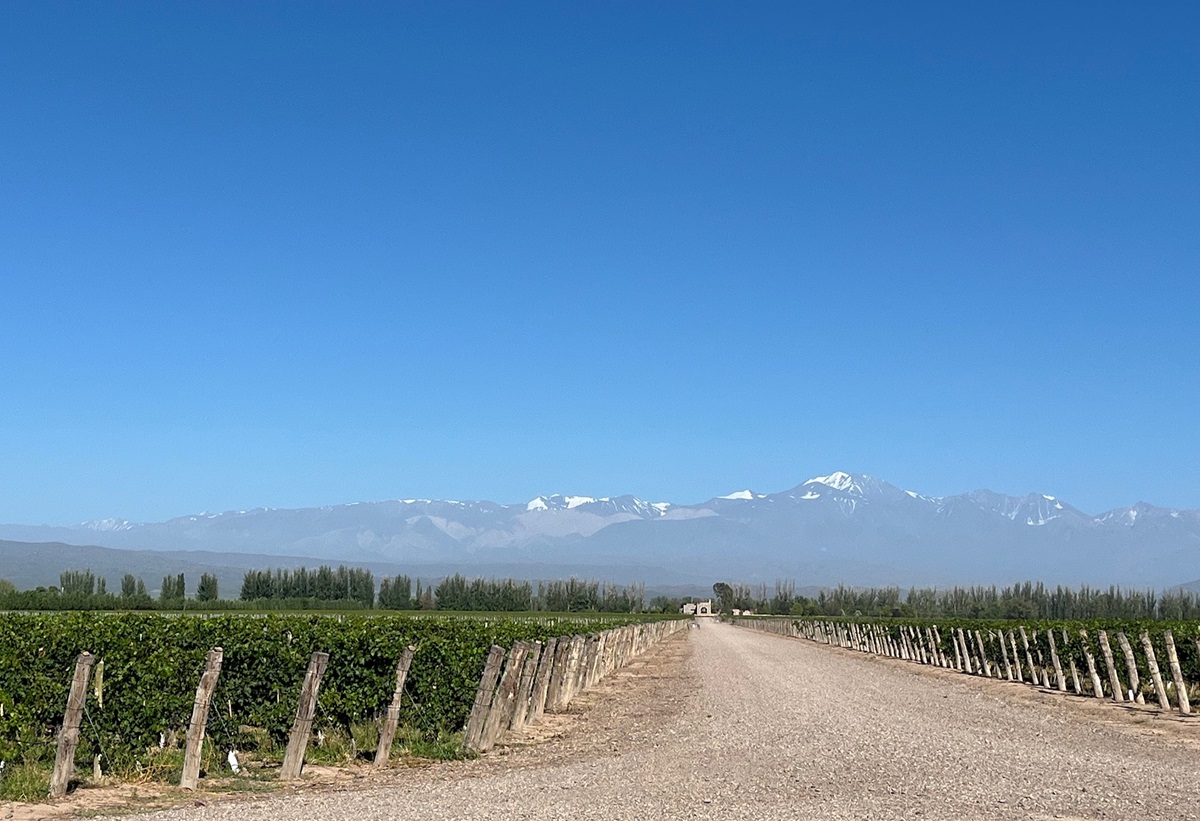CROATIAN WINE WITH AN IRISH TWIST
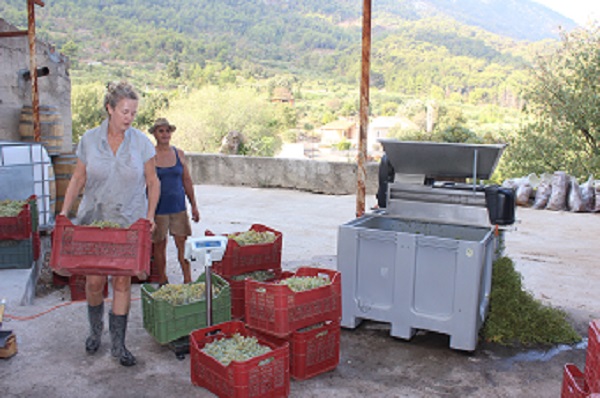
By Rose Murray Brown MW Published in The Scotsman 20 July 2019
Five years ago British-born flying winemaker Jo Ahearne MW left her job to go and live on a remote island to make her own wine.
The island she chose was one of the most beautiful in the Adriatic. Hvar, one and a half hour ferry ride from the Dalmatian coast, is renowned for stunning scenery of pine forests, olive groves and lavender fields, but it was not the scenic beauty that attracted Ahearne, it was the island’s steep vineyards and treasure trove of grapes.
“Croatia is like a mini-Italy with over 100 indigenous grapes – and Hvar is no exception. I have always been into local varieties and I felt the time was right as people were searching for something different to drink”, says Ahearne [pictured below making Plavac Mali].
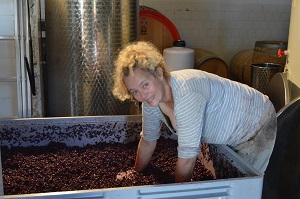 Interestingly, it was not love at first sight. “I first visited Croatia on holiday in 2003 when working as a winemaker in Australia. I thought it was beautiful, but after two days I started drinking beer as the local konoba (taverna) wine served to tourists was a bit dodgy”, she says.
Interestingly, it was not love at first sight. “I first visited Croatia on holiday in 2003 when working as a winemaker in Australia. I thought it was beautiful, but after two days I started drinking beer as the local konoba (taverna) wine served to tourists was a bit dodgy”, she says.
“Fast forward to 2014, whilst working as winemaker in neighbouring Macedonia I discovered Croatia’s potential. I was invited to a wine exhibition in Split, visited vineyards and saw how things had changed with increasing number of vineyards planted”.
“As someone who has not got enough money to buy vineyards and whose winemaking career started in Australia where everyone buys grapes, I thought I had enough experience to taste and assess grapes, so I knew I could find good grapes if they were there”, she says.
Ahearne chose to set her winery on Hvar as she felt it would be easier to get to know one island, rather than a whole country. Hvar is 42 miles long with a high east-west ridge of Mesozoic limestone and domolite – and a long history of growing vines. The Greeks first brought vines to the island 2000 years ago and in its heyday there were 3,500 hectares of vineyards; due to emigration, fires and economic crisis there are now only 350.
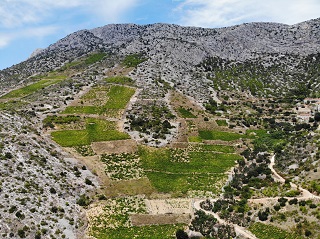 “My old boss Charlie Melton in Barossa in Australia used to say – get good grapes and don’t muck it up – so I applied his philosophy”, she says.
“My old boss Charlie Melton in Barossa in Australia used to say – get good grapes and don’t muck it up – so I applied his philosophy”, she says.
Ahearne knew good grapes were there, she just had to find them and persuade people to sell to her. When she arrived she knew no-one and admits she found it tough working alone, going for a month without conversation in winter. Despite speaking four languages, the complexity of Croatian village dialects still eludes her.
Hvar’s incredibly steep vineyard slopes proved another challenge [pictured below right]. “I found the steep vineyards terrifying – all small white rocks that slip and slide – with everything hand-tended. I am always out searching for new growers and vineyards; each year I look for a new vineyard and only if I find the right grapes can I increase production”.
Her other challenges are local bureaucracy, lack of wine logistics on the island, relying on a mobile bottling line – and generally the cost of running a winery in a remote location. “It’s not all Michelin-starred restaurants and lear-jets”, laughs Ahearne. “I spent an initial £20,000 set up and in the early days all my money went into buying grapes so I live frugally”.
“Everyone assumes grapes here are cheap. Plavac Mali costs the same as a good Oregon Pinot Noir or the best Coonawarra Cabernet, Bogdanusa is the same as 90 year old Barossa Semillon and Posip similar to Chardonnay in Tasmania”.
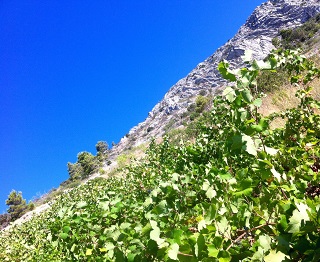 It is the quality and character of Croatian grapes that make it worthwhile. Her favourite grape is Darnekusa, a rare Hvar variety with only 1.5 hectares planted which she used for her first wine – a rose. She loves white Malvasija Dubrovacka from around Dubrovnik for its beautifully spicy nature and red Plavac Mali for its plummy character.
It is the quality and character of Croatian grapes that make it worthwhile. Her favourite grape is Darnekusa, a rare Hvar variety with only 1.5 hectares planted which she used for her first wine – a rose. She loves white Malvasija Dubrovacka from around Dubrovnik for its beautifully spicy nature and red Plavac Mali for its plummy character.
All these varieties were new to Ahearne when she arrived. She feels her 25 year winemaking career set her in good stead as she had worked with great names in the wine industry from Andrew Pirie at Pipers Brook to Bernie Hickin at Orlando. But it was blending wines worldwide as Marks & Spencer’s wine buyer that helped her most, as she learnt the balance and typicity of wines across many wine regions, helping her cope with new challenges in Dalmatia.
“I thought of Rioja when working with low acid Plavac Mali, but Barbaresco for tight knit tannins and floral notes. I used my work in Burgundy when dealing with Posip and my experience with Charlie Melton (the first to take rose seriously in Australia) and blending in Provence when I envisaged Rosina. Each step I had taken before brought me to making my own wines with enough background knowledge to cope”.
Ahearne describes her best moment as seeing the first wines bottled with her name on – the heron on the label relates to her family’s Irish crest. She makes four wines: Rosina rose, two whites, a Posip and maceration wine Wild Skins, and barrique-aged Plavac Mali South Side, sold at her cellar door – but two have just become available in the UK:
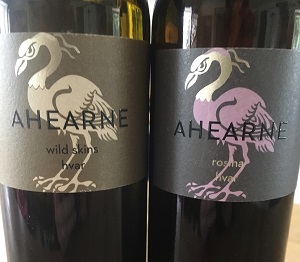 WILD SKINS 2017 Ahearne Vino (12%)
WILD SKINS 2017 Ahearne Vino (12%)
£30.60 Fine Wine Co www.thefinewinecompany.co.uk Exel Wines www.exelwines.co.uk
In the spirit of Croatia’s ‘natural wine’ history, Jo makes this refreshingly gentle introduction to the style; a blend of Kuc, giving spice and quince, Bagdanusa, adding citrus kick, and Posip giving palate richness. Ahearne feels some local varieties can be neutral, so macerates grapes on skins for a long period (15% was macerated for 340 days on skins; 85% between 10-20 days) to enhance flavour, with 9 months lees ageing, lees stirring and minimal sulphur and filtration.
Taste: Deep yellow, pungent rich lemon peel and ginger notes, rich textured complex palate, almost oily, with soft tannins – a beautifully-made orange wine.
ROSINA 2017 Ahearne Vino (11%) ***STAR BUY***
£27 Fine Wine Co www.thefinewinecompany.co.uk; Exel Wines www.exelwines.co.uk
Named after her mother, made from rare spicy high acid Darnekusa, this is a serious structured sophisticated style which could withstand some ageing – one of the best roses I have tasted.
Taste: Pale pink, herby earthy strawberry nose, fresh, vivid, sappy, cherry and raspberry fruits, dry on the finish – a deliciously delicate well-made rose with a strong backbone – very fine.
Contact details: https://www.facebook.com/AhearneVino/
Ahearne Vino, Vrisnik 130, Jelsa
21465 Hvar, Splitsko-Dalmatinska, Croatia
Join Rose’s Alsace v New Zealand tasting in Edinburgh on Thursday 17 October £45 www.rosemurraybrown.com
Join Rose for wine tastings in the Drinks Theatre at Foodies Festival, Inverleith Park, Edinburgh on Saturday 3 August and Sunday 4 August www.foodiesfestival.com
wine tastings
The perfect gift for the wine enthusiast in the family. Rose does In-person tastings too.
cellar advice
Rose does cellar valuations for private clients, valuations for insurers & bespoke portfolio management.
Related stories
March 31, 2024
By Rose Murray Brown MW Published in The Scotsman 30 March 2024 On 2 February 1659, the first wine made from grapes grown in South Africa was crafted by the Governor of the Cape, Jan van Riebeeck. He had planted vines four years earlier in the Company’s Garden near Cape Town from cuttings imported from France. Van Riebeeck’s first
March 24, 2024
By Rose Murray Brown MW Published in The Scotsman 16 March 2024 Heatwaves and bushfires were very much on the agenda when I visited Chile last month as winemakers prepared for their 2024 harvest in blistering heat and drought, with a plume of smoke from the devastating fires lingering over coastal hills. Heat and drought are the greatest challenges
March 23, 2024
By Rose Murray Brown MW Published in The Scotsman 9 March 2024 I have two glasses of Malbec in my hands from the same high-altitude vineyard in Uco valley in Argentina. I am in the Catena Institute of Wine in Mendoza with winemaker Agustin Silva. He has asked me to taste the two wines, both from the 1500m high



